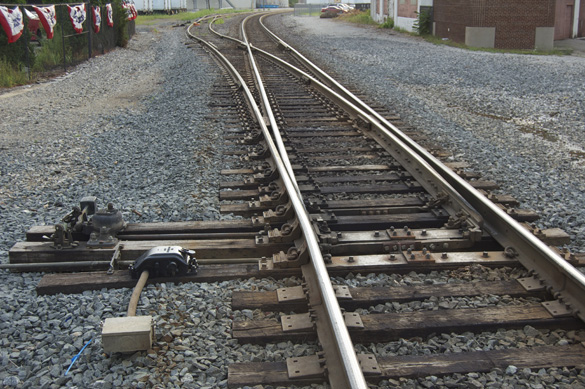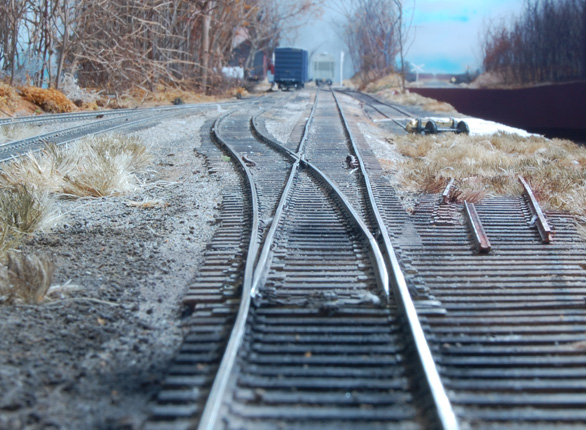For reasons unknown, the hobby defaulted short turnouts. I suppose it had something to do with the fact layouts used to be confined to 32 square foot chunks of space (4×8 sheets of plywood) and short turnouts let manufacturers sell more track per square foot. They also fit in with the sectional track systems of the train set era where the pieces were designed to be completely interchangeable. These track components are still widely available in multiple scales.
Pictured above is a turnout off the NS mainline in Richmond. I don’t know the frog number because I didn’t want to poke around on the tracks in a very public place. Needless to say it’s longer than a No. 6. I simply have a hard time picturing a quartet of Dash9s or a 2-8-4 tip-toeing through the typical No. 6 model turnout at track speed, yet that is exactly what happens on countless layouts. The rationale is that long turnouts take up too much space to be practical. I agree that a yard ladder of No. 10s in any scale will be a space hog but I disagree for other applications.
When people are going to great pains to wrap 600 foot mainlines around their layout space and default to Nos. 6-7 turnouts for mainline situations I have to wonder. Wouldn’t a No. 10 look so much better at the end of those 18-foot long passing sidings? You’re going to quibble over a few cars of lost train lengths over 10 scales miles of track in HO?
The N scale community could lead the way for the rest of us. They have the space ratio to really do flowing prototypical track work justice. A No. 10 mainline turnout could be the minimum and Nos. 12-15 are not unreasonable to consider in that scale.
However, if anything bigger than a No. 8 is considered as outrageous in HO or even N scales, it must be a pipedream in quarter-inch scale and yet, P48 No. 10 frog castings are readily available. Go figure. For much more about modeling track and turnouts, see our book Detailing Track.
Regards,
Mike
- No. 10 turnout on the I&W


Mike,
I have just completed a pattern for a number 12 rail-bound manganese insert frog in code 125 rail (100 lbs/yd). Now I need to make the pattern for 22 ft. long points for this frog, also I would like to do a pattern for the cast manganese steel guard rails.
John F. Pautz
American Switch & Signal
P:48 track components
Mike,
Judging by the points in your lead-in photo, I’d say that is a number 10 turnout. A.R.E.A. calls for 16’6″ long points for number 7,8,9 and 10 frogs and 22′ long points for number 11, 12 and 14 frogs, 30′ long points for number 16 and 20 turnouts.
John F. Pautz
American Switch & Signal
P:48 track components
Hi John,
Glad to know you read this blog. I don’t know what the frog number of the featured turnout is. Track speeds on this bi-directional line are in the 40-55mph range, so heavy trains take it at speed.
I find it interesting that P48 and quarter-inch scale, which everyone claims is too big to model anything, embraces longer turnouts more than the smaller scales. Go figure.
A well done No. 12 turnout would be a beautiful thing in any scale.
Regards,
Mike
Mike,
That track speed may be used for the straight throw route, but I can almost guarantee you the diverging route is limited to about 10 miles per hour.
John F. Pautz
American Switch & Signal
P:48 track components
The diverging route is a set-out track. It’s definitely speed restricted.
Mike